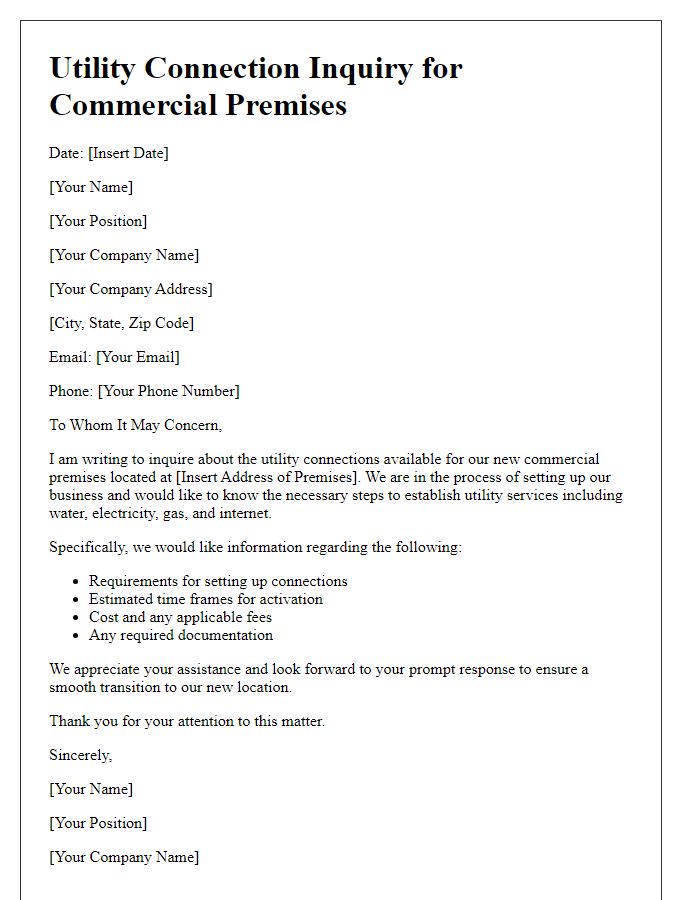Are you planning to connect a new utility service at your home or business? Completing a utility connection application can seem daunting, but it doesn't have to be! In this article, we'll guide you through the essential steps and provide a handy letter template to streamline the process. So, grab a cup of coffee and let's dive into the details to make your utility connection smooth and hassle-free!

Applicant Information
In the utility connection application process, the applicant information section is crucial for establishing the identity and purpose of the request. Typically, this section will require key details such as the full name of the applicant, which could include personal identifiers like the middle name or suffix for clarity. The address (including street name, number, city, and postal code) ensures the utility company can accurately locate the service area. Contact information, such as phone numbers (landline and mobile), and email addresses are essential for communication. Additionally, applicants might need to provide identification numbers, such as Social Security or Tax Identification numbers, to verify identity. Furthermore, the type of utility service requested (electricity, water, gas, etc.) should be clearly stated to streamline the processing of the application.
Service Address Details
In the utility connection application for a service address, it is essential to provide precise information to ensure timely processing. The service address, for instance, 123 Maple Street, Springfield, where the connection is requested, should include details such as the postal code (e.g., 62701) and nearby landmarks like Springfield Town Hall for easy identification. Specify the type of service, whether electricity, water, or gas, to facilitate the utility provider's understanding. Indicate any special requirements, such as an urgent connection, due to recent home renovation or new business establishment. Accurate contact information, including the applicant's name and phone number, helps the utility company reach out for verification or additional details.
Requested Service Type
When applying for a utility connection, it's crucial to specify the requested service type clearly. This may include electricity, water, gas, or sewage services, tailored to the specific needs of residential or commercial properties. For instance, electricity is often categorized into standard residential supply or three-phase commercial supply, with typical consumption rates varying by area (averaging 300 kWh monthly for homes). Water connections differ by usage patterns, such as irrigation systems versus standard household consumption, affecting connection sizes (e.g., 3/4 inch versus 1 inch). Gas service types might include natural gas for heating or cooking, with flow rates measured in BTUs (British thermal units). Each service type may require distinct forms, fees, and installation timelines, usually outlined by local utility agencies. Notable regions, such as California or Texas, often have specific regulations influencing applications, making it vital to research applicable local guidelines and requirements for a seamless connection process.
Preferred Connection Date
The preferred connection date for utility services, such as electricity or water, often plays a crucial role in ensuring timely access for residents and businesses. It is essential to coordinate this date considering factors like existing infrastructure, local regulations, and service provider availability. In many areas, such as urban centers or newly developed suburbs, typical processing times for utility connections can range from a few days to several weeks, depending on demand and the complexity of the installation. Selecting an optimal connection date often requires aligning schedules with professional technicians from utility companies, who will facilitate the installation and activation process, ensuring that services are operational when needed.
Contact Information and Preferred Contact Method
Completing a utility connection application requires precise contact information to ensure seamless communication. Key details include full name (along with middle initial for proper identification), residential address (including street number, city, state, and postal code), and phone number (with area code for telecommunication). Email address serves as an additional preferred contact method, allowing for quick correspondence. Utility companies, such as gas, electricity, and water providers, will often request this information to set up services efficiently and address any service inquiries. Proper documentation of contact preferences enhances response time and service reliability.
Letter Template For Utility Connection Application Samples
Letter template of utility connection application for temporary service.

Letter template of utility connection application for upgrade to existing service.

Letter template of utility connection application for emergency restoration.

Letter template of utility connection application for multi-unit residential buildings.

Letter template of utility connection request for special event services.

Letter template of utility connection inquiry for relocation of existing service.








Comments